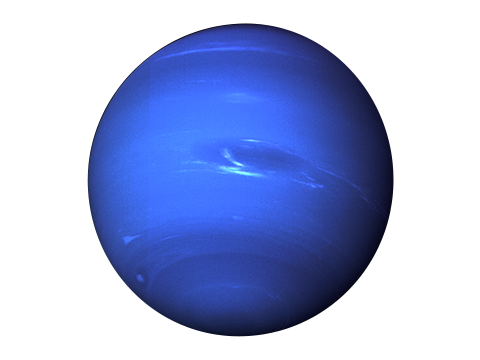Neptune Facts
Planet Profile
| Type | Ice Giant |
| Length of Year | 164.8 Earth year |
| Satellites | 16, known |
| Radius | 15,299 mi |
| Mass | 1.0243×1026 kg |
| Volume | 6.254×1013 km3 |
| Orbit Speed | 5.43 km/s, ave |
| Dist. from Sun | 4.5 billion km, ave |
Below are some of the facts about Neptune:
- Neptune is the last planet of the solar system and is placed between the orbits of Uranus and dwarf planet Pluto. It is one of the 4 gas giant planets.
- Mass of Neptune is 17 times that of Earth.
- Neptune has 14 moons. The largest moon is Triton. And Triton is also the coldest object in the solar system. It has been recorded to spill off dusts and nitrogen ice out of its core to its surface. Triton was believed once to be an independent object which got pulled by the gravity of Neptune and started orbiting the planet.
- Neptune has 5 rings. But they are very thin. They are made of dust and ice particles mixed together, and probably also have a coating of carbon based matter on them.
- Neptune takes 60,190 earth days to complete one orbit rotation around the sun, thereby making its one year equal to 164.8 Earth years.
- The average temperature on Neptune is around -214 degrees celcius.
- Neptune was first discovered in 1846.
- Neptune has a high speed of spinning around its axis. The equatorial cloud of Neptune takes 18 hours to complete one spin.
- The mass of Neptune is higher than that of Uranus although its size is small. That’s because of its composition and a deep rock core.
- Neptune has an atmosphere. This is formed of Helium in 25% and Hydrogen in 74% in gas forms. Methane is also there in 1%.
- Methane and icy particles in Neptune’s atmosphere absorbs the red light from the spectrum of sunlight reaching it, thereby imparting a very lovely blue color to the planet.
- The atmosphere of Neptune has two layers Troposphere and Stratosphere, divided by a partition Tropopause.
- The planet has a climate which is prominent with formation of storms and winds. The upper atmosphere experiences large storms and winds at a speed of 600 m/sec runs by the planet. Dark spots indicating storms can be seen.
- One storm which lasted for 5 years was recorded in 1989, and was named the Great Dark Spot. Wind speed of 1500 mph was recorded in it, and this is the highest speed recorded in a storm in a planet in the solar system.
- Neptune was visited by only one space shuttle until now, and that is Voyager 2. It happened in 1989, and captured images of the planet. Also the Hubble telescope captured some good images of the planet.
